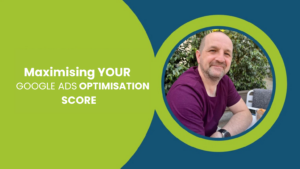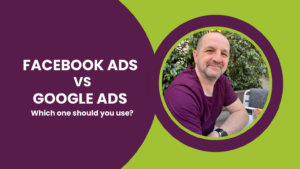Google Ads is a powerful tool that can help businesses reach their target audience through a variety of campaigns, including display campaigns. One key aspect of running a successful display campaign is choosing the right bidding strategy.
In this post, we explore the various bidding strategies available for Google Ads Display campaigns and explain each one.
This post is part of the Google Bidding Strategies Guide — created by our Google Ads Agency Team
In this series:
- Manual CPC Bidding in Google Ads: A Comprehensive Guide
- Enhanced CPC (eCPC) Bidding In Google Ads Explained
- How to Optimise Google Ads Using Target CPA Bidding
- How to Optimise Google Ads Using Target ROAS Bidding
- Google Ads Maximise Conversions Bidding Strategy Explained
- Google Ads Maximise Clicks Bidding Strategy Explained
- Google Ads Target Impression Share Bidding Strategy
- How and When to Use the Maximise Conversion Value Bidding Strategy in Google Ads
- Choosing the Best Bidding Strategy for Google Display Ads
- Every YouTube Ads Bidding Strategy Explained
- Bidding Strategies to Maximise Google Shopping Performance
- Manual Bidding vs Automatic Bidding: Which is Better?
Bidding Strategies for Google Ads Display Campaigns
- Cost-per-click (CPC) bidding: This bidding strategy allows you to set a maximum cost-per-click bid for your ads. You’ll only pay when someone clicks on your ad.
- Cost-per-thousand-impressions (CPM) bidding: With this bidding strategy, you’re bidding an amount for every 1,000 times your ad is shown.
- Viewable cost-per-thousand-impressions (vCPM) bidding: With vCPM bidding, you’ll only pay for ads that are viewable, meaning they meet certain criteria for visibility on the page.
- Maximise conversions bidding: This bidding strategy is designed to help you get the most conversions for your budget. You’ll set a budget and Google Ads will automatically adjust your bids and where your ads are shown to generate as many conversions as possible.
- Target cost-per-acquisition (tCPA) bidding: This bidding strategy is similar to CPA bidding, but you’ll set a specific target cost-per-acquisition and Google Ads will adjust your bids to meet that goal.
- Target ROAS bidding: You set a target return on ad spend (ROAS) and Google Ads automatically adjusts bids to meet that goal.
- Enhanced CPC (eCPC) bidding: Google Ads automatically adjusts your manual bids to help you get more conversions while maintaining the same cost per conversion.
- Maximise clicks bidding: Google Ads automatically sets your bids to help you get as many clicks as possible within your budget.
Choosing the right bidding strategy is crucial for running a successful Google Ads Display campaign. Each bidding strategy has its own benefits and drawbacks, so it’s important to carefully consider your goals and budget before making a decision.
Conversion Based Bidding Strategies
It is critical to note that bidding strategies based on conversion data will require conversion tracking to be configured correctly and accurately in order to produce the best results.
You should also remember that it is your web pages and your sales proposition which convert clicks into conversions. You should focus on Conversion Rate Optimisation on landing pages to optimise performance and to help scale your Google Ads campaigns.
Before enabling a conversion-based strategy, you should aim to have around 15 conversions in a 30 day period. This, and ongoing conversion data is used by the machine learning to optimise your performance – the more data available, the faster the machine will learn and the faster performance will be optimised.
Learn more:
- Conversion Rate Optimisation Services | CRO Agency
- Conversion Rate Optimisation Tips, Strategies and Advice
Manual CPC Bidding on the Google Ads Display Network
Manual CPC bidding is a bidding strategy available for Google Ads display campaigns that allows advertisers to set their own bids for each placement. With manual CPC, you set the maximum amount you are willing to pay for each click on your ad.
One of the biggest advantages of manual CPC bidding is the control it gives you over your campaign. By manually setting bids for each placement, you can allocate your budget more effectively and optimise your campaign for the best results.
However, manual CPC bidding can be time-consuming and requires regular monitoring to ensure that your bids are competitive and your campaign is performing well. Additionally, if you have a large number of placements, manual bidding can be challenging to manage and optimise.
To optimise your manual CPC bidding strategy, you can adjust your bids based on performance data, such as click-through rates and conversion rates. By regularly reviewing your performance data, you can adjust your bids to ensure that you are getting the best results for your budget.
It’s important to note that manual CPC bidding requires ongoing monitoring and optimisation, so it may not be the best option for businesses that don’t have the time or resources to manage their campaigns closely.
Learn more: Manual CPC Bidding in Google Ads: A Comprehensive Guide
Cost-per-Thousand-Impressions (CPM) Bidding on Display Ads
Cost-per-Thousand-Impressions (CPM) bidding is a type of bidding strategy used in Google Ads Display campaigns where you bid for every 1,000 impressions your ad receives.
Pros of CPM Bidding:
- More control over how often your ad is shown
- Better for brand awareness campaigns, where impressions and brand visibility are important
- Can be cheaper than other bidding strategies, such as Cost-per-Click (CPC)
Cons of CPM Bidding:
- May not generate as many clicks or conversions as other bidding strategies
- May be less effective for campaigns that are focused on driving conversions
- Can lead to wasted spend if your ad isn’t resonating with the target audience
Optimisation Opportunities:
- Test different ad creatives to see which ones perform best
- Adjust bids based on ad performance to ensure you’re getting the most value for your spend
- Utilise targeting options, such as geographic and demographic targeting, to reach your ideal audience more effectively
Overall, CPM bidding can be a useful strategy for campaigns focused on brand awareness and generating impressions. However, it may not be the best choice for campaigns that are focused on driving conversions. By testing and optimising your campaigns, you can ensure that you’re getting the most value from your CPM bidding strategy.
Learn more: How to Connect with Your Target Audience
Popular Google Ads Videos
Viewable Cost-per-Thousand-Impressions (vCPM) Bidding on Display Ads
Viewable cost-per-thousand-impressions (vCPM) is a bidding strategy used in display advertising that allows advertisers to pay only for viewable impressions. This means that the ad must be fully loaded and at least 50% of the ad’s pixels must be in view for at least one second.
The Pros of vCPM Bidding:
- Payment for viewable impressions only: Advertisers only pay for ad impressions that are viewable, reducing the possibility of wasted ad spend.
- Increased visibility: Advertisers can increase their ad’s visibility by bidding on viewable impressions, which can lead to higher engagement rates.
- Improved brand awareness: Higher engagement rates can also lead to improved brand awareness among the target audience.
The Cons of vCPM Bidding:
- Higher cost: Viewable impressions are more expensive than traditional impressions, which can result in higher costs for advertisers.
- Limited inventory: Not all ad inventory is available for viewable impressions, which can limit the reach of a campaign.
- Metrics limitations: Viewability is not a guarantee of ad effectiveness or conversion, so it’s important to track other metrics like click-through rate (CTR) and conversion rate.
vCPM Optimisation opportunities:
- Focus on ad creatives: Ad creatives play a significant role in the viewability of an ad. Optimising ad creatives to be visually appealing and engaging can increase the likelihood of viewability.
- Target high viewability placements: Advertisers should focus on targeting placements with high viewability rates to maximise the impact of their campaigns.
- Analyse data and adjust bids: Analysing campaign data and adjusting bids based on viewability rates can help optimise campaigns for better performance.
vCPM bidding is a good option for advertisers looking to increase their ad’s visibility and improve brand awareness, but it may not be the best option for every campaign. Advertisers should consider their goals, budget, and target audience before choosing a bidding strategy for their display ads.
Learn more: How to Connect with Your Target Audience
Maximise Conversions Bidding on Display Campaigns
The maximise Conversions bidding strategy is designed to automatically set bids for a campaign to help drive the most conversions possible within a given budget. This bidding strategy uses machine learning to optimise bids for each auction in real-time, based on the likelihood of a conversion.
Pros of Maximise Conversions:
- Maximise Conversions automatically sets bids based on the likelihood of a conversion, which saves time and effort.
- It can help to maximise the number of conversions that can be achieved within a given budget, making it ideal for businesses with a limited budget.
- It uses machine learning to optimise bids for each auction (gender, age, device, location, placement, time of day, day of week etc.) in real-time, which can help to improve campaign performance.
Cons of Maximise Conversions:
- There is no control over the cost per conversion with Maximise Conversions bidding.
- It can be less effective in campaigns with a high-value conversion or a long sales cycle.
Optimisation Opportunities:
- Optimise ad creatives: Maximise Conversions works best when paired with high-quality ad creatives which are likely to convert.
- Use demographic targeting: Demographic targeting can help to further optimise Maximise Conversions campaigns by focusing on audiences that are more likely to convert.
- Monitor performance: Regularly monitor campaign performance to ensure that Maximise Conversions is achieving the desired results. If not, consider adjusting the bid strategy or other campaign settings.
Learn more:
- Google Ads Maximise Conversions Bidding Strategy Explained
- 5 Ways to Make Your Landing Pages Convert
- Conversion Rate Optimisation Services | CRO Agency
Target Cost-per-Acquisition (tCPA) Bidding on Display Campaigns
Target Cost-per-Acquisition (tCPA) bidding is a bidding strategy that allows businesses to set a specific cost per acquisition goal for their campaigns. Google Ads will automatically adjust the bids to help achieve that goal.
Pros:
- Allows businesses to set a specific CPA goal and have bids adjusted automatically
- Helps ensure the highest possible conversion volume while maintaining the desired CPA
Cons:
- Requires enough conversion data to support machine learning
- May limit impression share if the desired CPA is too low
Optimisation Opportunities:
- Adjust the tCPA bid based on performance and conversion data
- Refine targeting to increase the likelihood of conversions
- Optimise landing pages for better conversion rates
tCPA bidding can be a powerful tool for businesses that have a specific CPA goal in mind and are looking to maximise conversion volume while maintaining that goal.
Learn more: How to Optimise Google Ads Using Target CPA Bidding
Target ROAS Bidding on Display Campaigns
Target ROAS (Return On Ad Spend) is a bidding strategy that allows advertisers to set a specific target for their return on ad spend. This is the amount of revenue generated for every pound spent on advertising.
By using this bidding strategy, Google Ads automatically adjusts bids in real-time to help achieve the desired return on investment. Bid adjustments are made across a number of dimensions in realtime; user device, age, gender, location, time of day, day of week, audience, location and others, all using historic conversion data from your campaign.
Pros:
- Allows advertisers to focus on generating revenue, rather than just clicks or impressions.
- Can be an effective strategy for businesses with a high average order value (AOV).
- Provides a more precise and measurable way to track and optimise campaign performance.
Cons:
- Requires a significant amount of conversion data to be effective.
- Can be a more complex bidding strategy to set up and manage.
- May result in lower traffic volume and reach compared to other bidding strategies.
Optimisation opportunities:
- Adjust the target ROAS based on performance and business goals.
- Optimise ad creatives and targeting to improve conversion rates and overall campaign performance.
- Analyse and adjust bids for different ad formats, placements, and audience segments to maximise return on ad spend.
Target ROAS can be an effective bidding strategy for businesses focused on generating revenue and maximising return on investment. However, it may not be the best fit for all campaigns and requires careful monitoring and optimisation to achieve optimal results.
Learn more:
Recent Google Ads Blog Posts
Enhanced CPC (eCPC) Bidding on Display Campaigns
Enhanced CPC (eCPC) bidding is a bidding strategy that is designed to help advertisers get more conversions while keeping their overall cost-per-click (CPC) in check. This bidding strategy works by automatically adjusting the advertiser’s CPC bid based on the likelihood of a conversion.
Pros of eCPC Bidding:
- Increased conversions: eCPC bidding can help increase the number of conversions an advertiser gets, since the system automatically adjusts bids to increase the likelihood of a conversion.
- Control over costs: eCPC bidding ensures that an advertiser does not overpay for clicks, as the system will adjust bids to keep the CPC in check.
- Easy to implement: eCPC bidding can be easily implemented by selecting it as a bidding strategy in the Google Ads interface.
Cons of eCPC Bidding:
- Limited control: While eCPC bidding does provide some control over costs, it also limits the advertiser’s ability to set specific bids for certain placements or keywords.
- Requires conversion data: In order for eCPC bidding to work effectively, the advertiser needs to have enough conversion data for the system to learn from. This can be a challenge for newer campaigns.
- Not suitable for all campaigns: eCPC bidding is most effective for campaigns that have a focus on conversions rather than clicks or impressions. It may not be suitable for campaigns that are aimed at building brand awareness or generating traffic.
Optimisation Opportunities:
- Regularly review and adjust bids: It’s important to regularly review and adjust bids to ensure that the eCPC system is optimising for the right conversions and not overspending on clicks.
- Focus on conversion rate optimisation: In order for eCPC bidding to work effectively, it’s important to focus on optimising the conversion rate of the landing page and the ad itself.
- Use negative keywords: Use negative keywords to prevent ads from appearing in irrelevant searches, which can improve the effectiveness of eCPC bidding.
Learn more: Enhanced CPC (eCPC) Bidding In Google Ads Explained
Maximise Clicks Bidding on Display Campaigns
maximise Clicks is a bidding strategy that allows businesses to automatically set bids to get as many clicks as possible within their budget. This bidding strategy is useful for businesses that want to drive as much traffic as possible to their website or landing page.
Pros of Maximise Clicks:
- Easy to set up and use, as the bidding is automated
- Can drive a significant amount of traffic to your website or landing page
- Helps increase brand awareness and visibility
- Can be useful for remarketing campaigns or for promoting a limited-time offer or sale
Cons of Maximise Clicks:
- Clicks do not always translate into conversions or sales, so businesses need to track their metrics carefully to ensure they are not overspending on clicks that do not convert
- There is a risk of low-quality clicks or click fraud, which can negatively impact the overall performance of the campaign
- The bidding strategy does not take into account the quality of the clicks, which can result in low engagement rates or high bounce rates
Optimisation Opportunities:
- Monitor the performance of the campaign regularly and adjust bids accordingly to maximise return on investment
- Use audience targeting and ad placement options to ensure the clicks are coming from the right audience and are more likely to convert
- Set up conversion tracking and optimise for the best-performing ads and placements to improve the overall campaign performance
- Use negative keywords and exclusions to avoid irrelevant clicks and reduce wasted ad spend.
Learn more: How to Connect with Your Target Audience










